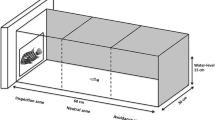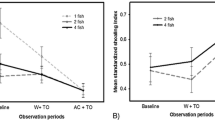Abstract
The ability to acquire information about predators allows prey to better balance threat-sensitive tradeoffs by responding only to ecologically relevant predation threats. However, predation risk is highly variable through time and responding to predators that no longer represent a threat would likely prove costly to prey. While a wealth of studies have examined the way in which prey learn, little attention has been paid to retention of acquired information. Recent studies suggest that retention is indeed plastic and shaped by a suite of intrinsic factors such as strength of initial conditioning and individual growth rate. Here, we investigated if the duration of retention of acquired information is influenced by individual behavioral tactics (i.e., ‘personality’). We recorded latency to escape an opaque acclimation chamber of juvenile rainbow trout (Oncorhynchus mykiss) as a measure of behavioral tactic. We then immediately conditioned individual trout to recognize pumpkinseed (Lepomis gibbosus) and tested for recognition 24 h or 8 days postconditioning. Our results demonstrate that while shy versus bold trout exhibited no difference in the strength of conditioned response to pumpkinseed odor during conditioning trials or when tested for recognition 24 h postconditioning, there was a significant effect of individual behavioral tactic on the retention of learned predator recognition. While shy trout continued to exhibit a learned response to pumpkinseed odor when tested 8 days postconditioning, bold trout were not different from our pseudoconditioned controls. These data suggest that the behavioral tactic employed at the time of conditioning influences the ‘memory window’ of acquired information.


Similar content being viewed by others
References
Adriaenssens B, Johnsson JI (2011) Learning and context-specific exploration behaviour in hatchery and wild brown trout. Appl Anim Behav Sci 132:90–99
Biondi LM, Bó MS, Vassallo AI (2010) Inter-individual and age differences in exploration, neophobia and problem-solving ability in a neotropical raptor (Milvago chimango). Anim Cogn 13:701–710
Biro PA, Abrahams MV, Post JR, Parkinson EA (2004) Predators select against high growth rates and risk-taking behaviour in domestic trout populations. Proc R Soc Lond B 271:2233–2237
Brown C, Braithwaite V (2004) Size matters: a test of boldness in eight populations of the poeciliid Brachyraphis episcopi. Anim Behav 68:1325–1329
Brown GE, Chivers DP (2005) Learning as an adaptive response to predation. In: Barbosa P, Castellanos I (eds) Ecology of predator–prey interactions. Oxford University Press, Oxford, pp 34–54
Brown GE, Godin J-GJ (1999) Who dares, learns: chemical inspection behaviour and acquired predator recognition ina characin fish. Anim Behav 57:475–481
Brown GE, Schwarzbauer EM (2001) Chemical predator inspection and attack cone avoidance in a Characin fish: the effects of predator diet. Behaviour 138:727–739
Brown GE, Smith RJF (1996) Foraging trade-offs in fathead minnows (Pimephales promelas, Osteichthyes, Cyprinidae): acquired predator recognition in the absence of an alarm response. Ethology 102:776–785
Brown GE, Smith RJF (1998) Acquired predator recognition in juvenile rainbow trout (Oncorhynchus mykiss): conditioning hatchery-reared fish to recognize chemical cues of a predator. Can J Fish Aquat Sci 55:611–617
Brown GE, Golub JL, Plata D (2001) Attack cone avoidance during predator inspection visits by wild finescale dace (Phoxinus neogaeus): the effects of predator diet. J Chem Ecol 27:1657–1666
Brown C, Jones F, Braithwaite V (2005) In situ examination of boldness-shyness traits in the tropical poeciliid, Brachyraphis episcopi. Anim Behav 70:1003–1009
Brown GE, Bongiorno T, Cicapua DM, Ivan LI, Roh E (2006) Effects of group size on the threat-sensitive response to varying concentrations of chemical alarm cues by juvenile convict cichlids. Can J Zool 84:1–8
Brown GE, Ferrari MCO, Chivers DP (2011a) Learning about danger: chemical alarm cues and threat-sensitive assessment of predation risk by fishes. In: Brown C, Laland K, Krause J (eds) Fish cognition and behaviour, 2nd edn. Blackwell, West Sussex, pp 59–80
Brown GE, Ferrari MCO, Malka PH, Oligny M-A, Romano M, Chivers DP (2011b) Growth rate and retention of learned predator cues by juvenile rainbow trout: faster-growing fish forget sooner. Behav Ecol Sociobiol 65:1267–1276
Budaev S, Brown C (2011) Personality traits and behaviour. In: Brown C, Laland K, Krause J (eds) Fish cognition and behaviour, 2nd edn. Blackwell, West Sussex, pp 135–165
Carter AJ, Goldizen AW, Tromp SA (2010) Agamas exhibit behavioral syndromes: bolder males bask and feed more but may suffer higher predation. Behav Ecol 21:655–661
Chivers DP, Smith RJF (1998) Chemical alarm signaling in aquatic predator–prey systems: a review and prospectus. Ecoscience 5:338–352
Curio E, Ernst U, Vieth W (1978) The adaptive significance of avian mobbing: II. Cultural transmission of enemy recognition in blackbirds: effectiveness and some constraints. Z Tierpsychol 48:184–202
Dall SRX, Johnstone RA (2002) Managing uncertainty: information and insurance under the risk of starvation. Philos T Roy Soc B 357:1519–1526
Dall SRX, Giraldeau L-A, Olsson O, McNamara JM, Stephens DW (2005) Information and its use by animals in evolutionary ecology. Trends Ecol Evol 20:187–193
Dingemanse NJ, Wright J, Kazem AJN, Thomas DK, Hickling R, Dawnay N (2007) Behavioural syndromes differ predictably between 12 populations of three-spined stickleback. J Anim Ecol 76:1128–1138
Dugatkin LA, Alfieri MS (2003) Boldness, behavioral inhibition and learning. Ethol Ecol Evol 15:43–49
Dugatkin LA, Godin J-GJ (1992) Prey approaching predators: a cost–benefit perspective. Ann Zool Fenn 29:233–252
Ferrari MCO, Messier F, Chivers DP (2007) First documentation of cultural transmission of predator recognition by larval amphibians. Ethology 113:621–627
Ferrari MCO, Wisenden BD, Chivers DP (2010a) Chemical ecology of predator–prey interactions in aquatic ecosystems: a review and prospectus. Can J Zool 88:698–724
Ferrari MCO, Brown GE, Bortolotti GR, Chivers DP (2010b) Linking predator risk and uncertainty to adaptive forgetting: a theoretical framework and empirical test using tadpoles. Proc R Soc Lond B 277:2205–2210
Ferrari MCO, Brown GE, Jackson CD, Malka PH, Chivers DP (2010c) Differential retention of predator recognition by juvenile rainbow trout. Behaviour 147:1791–1802
Ferrari MCO, Brown GE, Bortolotti GR, Chivers DP (2011) Prey behaviour across antipredator adaptation types: how does growth trajectory influence learning of predators? Anim Cogn 14:809–816
Godin J-GJ, Dugatkin LA (1996) Female mating preference for bold males in the guppy, Poecilia reticulata. P Natl Acad Sci USA 93:10262–10267
Godin J-GJ, Smith SA (1988) A fitness cost of foraging in the guppy. Nature 333:69–71
Golub JL, Vermette V, Brown GE (2005) Response to conspecific and heterospecific alarm cues by pumpkinseeds in simple and complex habitats: field verification of an ontogenetic shift. J Fish Biol 66:1073–1081
Gonzalo A, López P, Martín L (2010) Risk level of chemical cues determines retention of recognition of new predators in Iberian green frog tadpoles. Behav Ecol Sociobiol 64:1117–1123
Griffin AS, Evans CS, Blumstein DT (2001) Learning specificity in acquired predator recognition. Anim Behav 62:577–598
Harris S, Ramnarine IW, Smith HG, Pettersson LB (2010) Picking personalities apart: estimating the influence of predation, sex and body size on boldness in the guppy Poecilia reticulata. Oikos 119:1711–1718
Helfman GS, Winkleman DL (1997) Threat sensitivity in bicolor damselfish: effects of sociality and body size. Ethology 103:369–383
Hirvonen H, Ranta E, Rita H, Peuhkuri N (1999) Significance of memory properties in prey choice decisions. Ecol Model 115:177–189
Jones KA, Godin J-GJ (2010) Are fast explorers slow reactors? Linking personality type and anti-predator behaviour. Proc R Soc Lond B 277:625–632
Licht T (1989) Discriminating between hungry and satiated predators: the response of guppies (Poecilia reticulata) from high and low predation sites. Ethology 82:238–242
Lima SL, Steury TD (2005) Perception of predation risk. In: Barbosa P, Castellanos I (eds) Ecology of predator–prey interactions. Oxford University Press, Oxford, pp 166–188
López P, Hawlena D, Polo V, Amo L, Martín J (2005) Sources of individual shy-bold variations in antipredator behaviour of male Iberian rock lizards. Anim Behav 69:1–9
Martel G, Dill LM (1993) Feeding and aggressive behaviors in juvenile coho salmon (Oncorhynchus kisutch) under chemically-mediated risk of predation. Behav Ecol Sociobiol 32:365–370
Mathot KJ, Wright J, Kempenaers B, Dingemanse NJ (2012) Adaptive strategies for managing uncertainty may explain personality-related differences in behavioural plasticity. Oikos 121:1009–1020
McLean IG, Lundie-Jenkins G, Jarma PJ (1996) Teaching an endangered mammal to recognize predators. Biol Conserv 56:51–62
McNamara JM, Houston AI (1987) Memory and the efficient use of information. J Theor Biol 125:385–395
Mirza RS, Chivers DP (2000) Predator recognition training enhances survival of brook trout: evidence from laboratory and field enclosure studies. Can J Zool 78:2198–2208
Nieuwenhuis S, Forstmann BU, Wagenmakers E-J (2011) Erroneous analyses of interactions in neuroscience: a problem of significance. Nat Neurosci 14:1105–1107
Pellegrini AFA, Wisenden BD, Sorensen PW (2010) Bold minnows consistently approach danger in the field and lab in response to either chemical or visual indicators of predation risk. Behav Ecol Sociobiol 64:381–387
Quinn JL, Cresswell W (2005) Personality, anti-predation behaviour and behavioural plasticity in the chaffinch Fringilla coelebs. Behaviour 142:1377–1402
Réale D, Reader SM, Sol D, McDougall PT, Dingermanse NJ (2007) Integrating animal temperament within ecology and evolution. Biol Rev 82:291–318
Reinhardt UG, Healey MC (1999) Season- and size-dependent risk taking in juvenile coho salmon: experimental evaluation of asset protection. Anim Behav 57:923–933
Roberts LJ, Taylor J, Garcia de Leaniz C (2011) Environmental enrichment reduces maladaptive risk-taking behavior in salmon reared for conservation. Biol Conserv 144:1972–1979
Sih A (1992) Prey uncertainty and the balancing of antipredator and foraging needs. Am Nat 139:1052–1069
Sih A, Bell A, Johnson JC, Ziemba RE (2004) Behavioral syndromes: an integrative overview. Quart Rev Biol 79:241–277
Stephens DW (1987) On economically tracking a variable environment. Theor Popul Biol 32:15–25
Titulaer M, van Oers K, Naguib M (2012) Personality affects learning performance in difficult tasks in a sex-dependent way. Anim Behav 83:723–730
Vavrek MA, Brown GE (2009) Threat-sensitive responses to disturbance cues in juvenile convict cichlids and rainbow trout. Ann Zool Fenn 46:171–180
Wilson ADM, Godin J-GJ (2009) Boldness and behavioral syndromes in the bluegill sunfish, Lepomis macrochirus. Behav Ecol 20:231–237
Wilson ADM, McLaughlin RL (2007) Behavioural syndromes in brook charr, Salvelinus fontinalis: prey-search in the field corresponds with space use in novel laboratory situations. Anim Behav 74:689–698
Woody DR, Mathis A (1998) Acquired recognition of chemical stimuli from an unfamiliar predator: associative learning by adult newts, Notopthalmus viridescens. Copeia 1998:1027–1031
Acknowledgments
We thank Jean-Guy Godin, Robert Weladji, and James Grant for discussion and comments on earlier versions of this manuscript. Financial support was provided by Concordia University and the Natural Sciences and Engineering Research Council of Canada to GEB and the University of Saskatchewan and NSERC to DPC.
Author information
Authors and Affiliations
Corresponding author
Additional information
Communicated by N. Dingemanse
Ethical standards
All work reported herein was conducted in accordance with all national and provincial regulations governing animal care and approved by Concordia University Animal Research Ethics protocol #AREC-2008-BROW.
Rights and permissions
About this article
Cite this article
Brown, G.E., Ferrari, M.C.O., Malka, P.H. et al. Retention of acquired predator recognition among shy versus bold juvenile rainbow trout. Behav Ecol Sociobiol 67, 43–51 (2013). https://doi.org/10.1007/s00265-012-1422-4
Received:
Revised:
Accepted:
Published:
Issue Date:
DOI: https://doi.org/10.1007/s00265-012-1422-4




